The world’s last gun cruisers. Started before the war in 1939 in a very different context, to join the KNIL defending the Netherlands East Indies against the Japanese, they were under construction when the country was invaded by Germany in 1940. De Ruyter and De Zeven Provinciën were not advanced enough to have been completed for the Kriegsmarine and instead in 1945, the design was considerably revised, and they ended as AA escorts for the new Dutch aircraft carrier Karel Doorman. Displacing almost 12,000 tonnes fully loaded, they were the largest warships ever built in the Netherlands, and when completed in 1953, were among the world’s best conventional “light” cruisers in service. Resold to Peru in 1973-76, they started an even longer second life as BAP Aguirre and Almirante Grau until 1999 and 2017… #netherlandsnavy #dutchnavy #deruyter #dezevenprovincien #cruiser
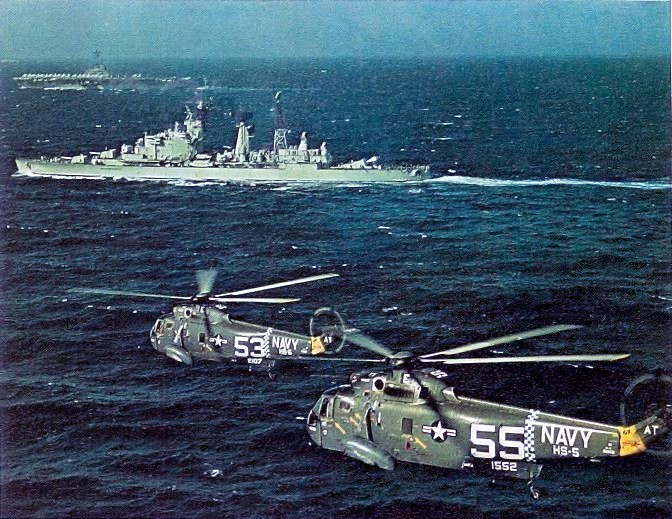
HNMLS De Zeven Provincien escorting USS Essex in a 1967 exercize
Origins and Development (1939-1950)
To open the ball on Dutch warships of the cold war, our first entry are the escorts of Karel Doorman for most of her service: The De Ruyter class cruisers. Not only they are probably the last conventional cruisers completed in Europe, but also certainly among the most intriguing, with the longest and most convoluted history and development.
This story starts with an evolution of the first HNMLS De Ruyter, a 1935 light cruiser that was famously Admiral Karel Doorman’s flagship at the battle of Java, where she fought and sunk against the Japanese. But this was in 1942, and our story starts with a replacement project for this cruiser, which was a compromised design. It was recoignized in 1937 already that the Japanese (which just attacked China) were indeed a militaristic nation with strong nationalist and expansionist policy and agressive attitude in the Pacific.
The KNIL (Royal Netherlands East Indies Army) was indeed worried about these development and a vigorious naval program, now entering a new phase of “fog of war” after Japan ripped off all treaties post-1935. Dutch intel about IJN cruisers in particular was worrying enough. The admiralty thus started working on a replacement class for the two elderly Java class cruisers (1923). The result of this foray in 1938 was the four turrets light cruisers of the Eendracht class.
https://nl.wikipedia.org/wiki/De_Zeven_Provinci%C3%ABnklasse_(kruiser)
http://www.military-today.com/navy/de_zeven_provincien_cruiser.htm
The Kijkduin (Eendracht) class (1939)

So, the 1930s awareness about the IJN threat led to the naval expansion program of 1932 to replace the Java-class cruisers, but it evolved over the years as a replacement for the HNLMS De Ruyter, until the design was ready and approved and two keels were laid down in 1939. HNLMS Kijkduin (later C802) was the initial lead ship (later pennant C802), in Yard N°219 at Rotterdamsche Droogdok Mij in Rotterdam on 19 May 1939.
Her sister ship was to be named HNLMS De Zeven Provinciën under Yard 670 at Wilton-Fijenoord, Schiedam, on 5 September 1939. Later the lead ship was renamed Eendracht (her sister kept the De Zeven Provinciën name), hence the class name they kept in WW2. They were conceived as improvements over the first De Ruyter cruiser design (1935), having instead of the poor arrangement of three twin turrets and a single gun, and full battery of ten guns in two twin, two triple turrets, notably to face the latest Mogami class cruisers (five triple turrets). Thanks to the most modern techniques, the new triple turrets could be made only with a slight increase in cost and weight, so that the Kijkduin and De Zeven Provinciën would have a significant increase in combat power.

WoW’s rendition of the original Eendracht
The ships were much larger than the previous De Ruyter or Java class, reaching 8,350 tonnes standard, up to 10,000 tonnes fully loaded, ten main guns in superfiring twin and triple turrets for and aft, and a generous AA, between six twin 40mm, four twin 12.7mm (British Vickers 0.50″/62 (12.7 mm) MG Mark III) and two triple torpedo tubes banks amidships, plus two FOKKER C.XI floatplanes.
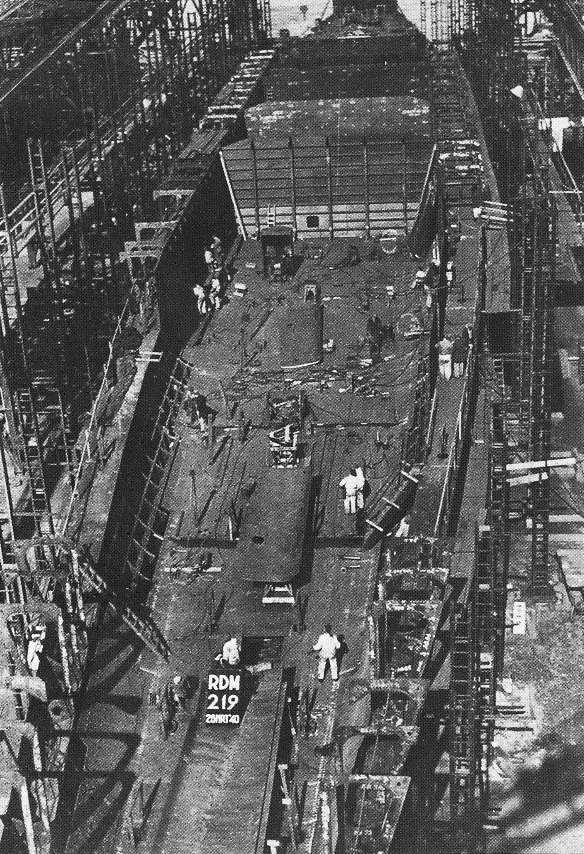
Hull number 219 in prewar construction, 26 March 1940 in Rotterdam. Only photo known of that era. E.C. Fisher Jr. coll.
Unfortunately war broke out as soon as they were laid down. In fact, De Zeven Provinciën started a few days after the invasion of Poland. Construction went on until interrupted by the German invasion on 10 May 1940. De Zeven Provinciën was at that stage 25% complete, Kijkduin only 12%. Immediately a commission from the Kriegsmarine came to examine their possible launch and completion under German standards. The main armament for De Zeven Provinciën (unnamed at that stage) was planned to be four twin 15 cm SK C/28 guns and for Eendracht a yet unknown arrangement with spare 15cm guns from recently broken up pre-dreadnought battleship.

De Zeven Provincien in construction, 1945. E.C. Fisher Jr. coll.
Exact composition is unknown. Work on De Zeven Provinciën was advanced enough she was renamed KH1 (for “Kreuzer Holland, 1”) modified with the late “Atlantic Bow” while Eendracht was renamed KH2, but benefited from less attention. Work progressed still slowly as workers were often used for repairing others ships and sabotage by the Dutch resistance. On 24 December 1944 KH1 was at last launched, but at this stage it was clear Holland was about to fall and she could not be towed to Germany due to the mastery of the air of the allies, and she was to be sunk as a blockship in the Nieuwe Waterweg, Rotterdam. But this never happened. Rotterdam was freed on April 1945. The needed to have the port running again was pressing, and the Dutch authorities soon recovered the hull of the first cruiser relatively intact.
⚙ Eeendracht class specifications 1939 |
|
| Dimensions | (182.4 pp)185.7 oa x 17.3 x 5.60 m |
| Displacement | 8,529t standard, 11,850t FL |
| Propulsion | 3 Parsons geared steam turbines, 6 Yarrow boilers 78,000 shp |
| Speed | 32 knots (59 km/h; 37 mph) |
| Protection | Belt 75-100mm, deck 20-25mm, turrets 50-100mm |
| Range | Oil 1,750t, 6,000nm at 12 kts |
| Armament | 2×3, 2×2 152mm/53, 6×2 40mm/56 Bofors AA, 4×2 12.7mm/62, 2×3 533mm TT, 2 seaplanes |
| Crew | 700 |
Complete redesign, the De Ruyter class (1945-1950)
The 1945-47 Design
The 1945-47 Design
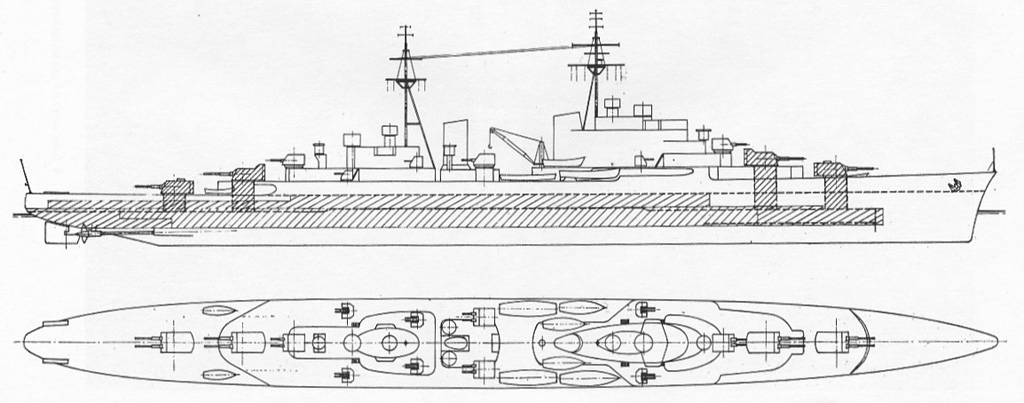
De Zeven Provinciën, 1947 preliminary design plan. Note the heavy British influence here, with the low superstructures and tripod masts. By Arthur Davidson Baker III.
After the Second World War, the design was modified based on experiences from the war. The engine rooms were further sub-divided and two funnels installed instead of one, plus there was a maximum displacement of 12,040 tons, while the hull was half a meter longer and provision was made for future radar equipment, likely of British provenance. The main armament was to be kept although the fire control greatly improved and the AA modernized, and the catapults and seaplanes removed.
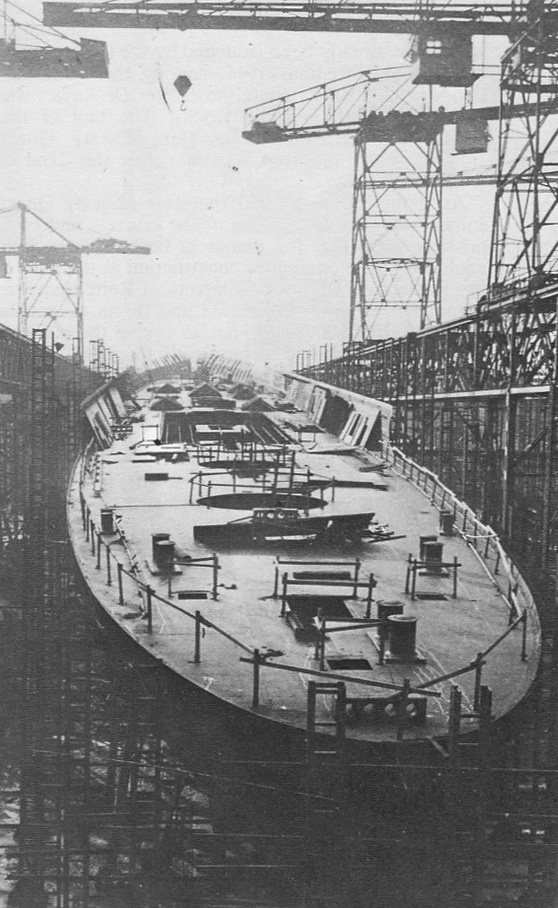
De Zeven Provincien in construction, 1947. E.C. Fisher coll.
Final AA Armament was solidified with six twin 40 mm AA, but the two triple 533 mm torpedo tubes were kept at least before the 1949 revision. There were still four twin Bofors 152 mm/53 guns, four twin Bofors 57 mm/60 guns but also eight single Bofors 40 mm/70 guns, auite an increase in AA firepower. The propulsion plant was imprived by changing the prewar configuration by adopting locally-produced turbines and boilers using the latest in steam technology. The fewer boilers were exhausted now in two funnels instead of a single one, as there was no need for a “mack” at that stage. The superstructures were more developed but at the same time lower than the final ships, resembling 1945 British cruiser projects. They would even have been fitted with lattice masts for the radars.
Names later were changed: Eendracht became “De Zeven Provinciën” and the former namesake was renamred “De Ruyter”.
Final Design
Hull design and protection
As completed the ships had a very different profiles as per the 1947-1950 readjustments. Instead of the “long and low” 1947 profile, the redesign put the emphasis on flagship facilities and integration of very string radar masts by using the “mack” combination which started to be popular. The end result was a much taller silhouette, with the two funnels were raised and lattice tripods placed immediately aft and ore of these, and in the case of the forefunnel, it was fully integrated with the antenna mast. The end result was a ship with raised superstructures to the middle, peaking in a way that made it intimidating.
These ships had a presence that oozed power, almost a “warships’ warship”, a general outlook absolutely not associated with a light cruiser, and quite odd as the turrets were dwarved by the rest. As they ended with only four twin turrets, this was the same as the 4,000 tonnes interwar Leander class to put shings in perspective. They sure served their purpose well as flagships as well, as they looked the part as flagships, and sure were an asset in Dutch postwar colonial years.
This profile started with the two fore turrets, with the second twin superimposed on a suprstructure and not just a barbette. Next came a new level wich supported the fore twin Mark 33 AA mount. Behind came another level on which was mounted its dedicated fire control system. Two levels above and behind came the main navigation bridge. It was partially open, with short wings. Then came behind on another upper level, the enclosed admiral or flagship bridge. It was surrounded by extra wings and another open deck. Behind was located a pyramid-like structure supporting the main fire control system for the two fure funnels. The came one level higher another utility bridge, with wings on two levels either side.
The tall fore mack was located just behind, supporting a platform for a navigation radar, the the mast proper, much taller and supporting a radar aerial and various antenna and detectors. The funnel ducted ended with a capped exhaust right behind.
The amidship section, in between islands, was logically filled with service boats on various davits and on the roof of the superstructure in between, served by two cranes either side of the mack. It should be noted that the four forward Bofors mounts, fully shielded were installed in their own baththub positions along the tall bridge superstructure. Then came the tw amidship 76 mm mounts, placed on extension of the superstructure. The aft, tall tripod lattice mainmast started there, with the outer legs resting on either sides of the aft funnel, quite tall. This aft tripod supporting the remaining aerial radar.
Then came the aft superstructure, still tall to support the two superposed aft firing control systems, for the two aft turrets and the aft 76 mm AA mount. The hull was not flush but stepped down at the lower deck turret level. The tall superstructures were handy to accomodate the large crew (almost 1,000 !), but acted as sails in the wind. They were a stability concerns as well, albeit engineers made sure to compensate by using oil, ammunitions and other fluids and storage placed as low as possible.
Propulsion
The propulsion of the Zeven Provinciën class cruisers consisted of two steam turbines, driven by four boilers. All exhausts were truncated into two tall funnels. Total output was 62,560 kW, enabling a top speed of 32 knots (in tropical waters). When at 12 knots, they reached 13,000 kilometers (xxx nautical miles). This power was passed onto two propellers, but she ship could still operate with a single propeller using the rudder to compensate. Two engine rooms and two boilers rooms were accomodated for protection and survivability.
Armament
The primary armament of the ships has been the subject of intense discussions in the naval staff, notably over the type of gun to use, even before the numbers and locations of these. Many wanted initially (the 1947 early design phase) that British guns should be installed, as a safe and relatively cheap purchase. However some had the opinion that the very latest Swedish Bofors guns were a superior proposition with better guidance and higher rate of fire. They were also compact, offiring more space for modernization. This faction utimately won.
The other big change was the abandon of the triple turrets for twin turrets, to save weight, preserve stability, and overall because the twin turrets were already ready whereas the triple ones were still in development. Postwar many thought that the number of barrels was less important than accuracy with radar guidance.
Main: 4×2 6-in/53 Bofors
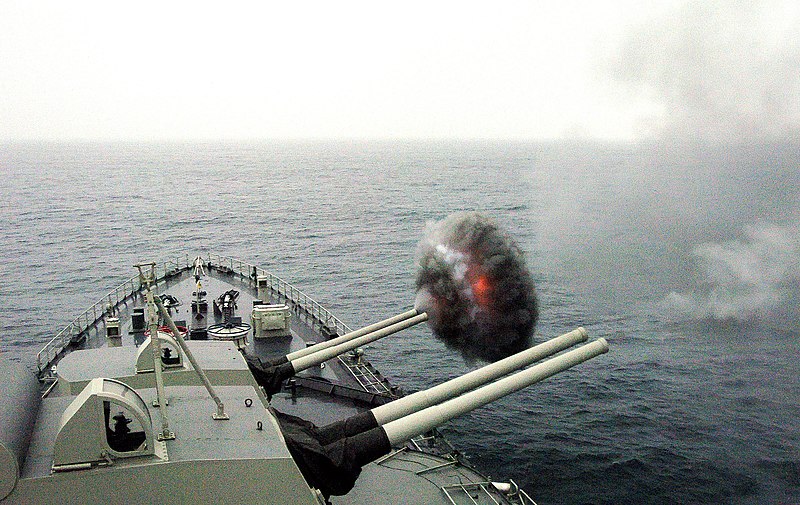
So the ships ended with eight 6-in/53 (152mm) guns in four twin turrets. For their size, it was weak for WW2 standard, but that was not the point.
Indeed, these guns had a very high rate of fire at the time, up to 10 to 15 rounds per barrel and per minute, which was comparable or better to the Worcester‘s Mark 16DP (12 rounds per minute), without the tecnhnical issues of the latter. Ammunition supply was the only problem with these guns, and slowed down the rate of fire as a result in practice, below 8 rpm. The cooling systems and mount electrical drive, hydraulic parts, and aiming systems were all made by Hollandse Signaalmachines.
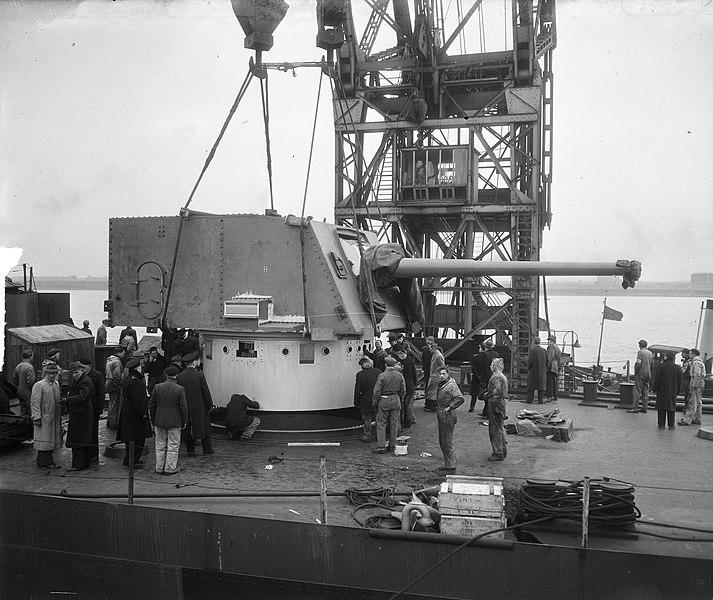
Specs:
Shell 45.8 kg (99 lb), 32.6 kg charge, Elevation -10 to +60°
Maximum firing range: 28,400 yards (26,000 m)
Rate of fire: 12-15 shots /min
Secondary: 4×2 57mm SAK L/60 Bofors
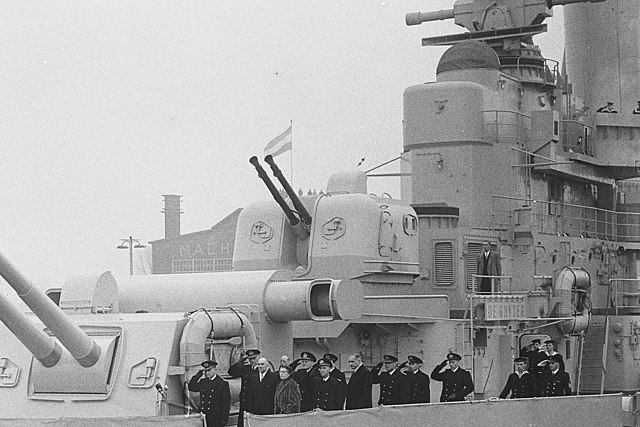
The ships had eight 24 tonnes 57mm anti-aircraft guns, spread over four twin turrets, which can be used also against surface targets. The SAK 60 was also used by the French and Swedish Navies. It fired a 57 × 438 mm R (m/50) shell weighting 2.6 kg. The turreted mount could elevate to -9°/+90° at 30°/s and fully traverse at 30°/s, with a rate of fire of 2×130 rounds/min at a muzzle velocity of 850 to 920 m/s and an effective firing range of 13,000 metres (42,650 ft) max, 5,000 metres practical (16,400 ft) with a 5,500 meters (18,000 ft) AA ceiling.
Tertiary: 8×1 40 mm Bofors
The eight 40mm guns in eight single mounts, shielded and placed on either side along the superstructures fore and aft. The Bofors 40 mm Automatic Gun L/70 entered service in 1952. It was the pinnacle of development for the interwar venerable Bofors, one of the most iconic piece of ordnance of all times. It was copied by BAE, Breda and largely exported. The list of countries is just endless. The gun weighted 2,400 kg (5,300 lb) with a barrel lenght of 2,800 mm (9 ft 2 in). It fired Cartridge 40 × 365 mm R weighting 0.96 kg (2.1 lb) at 240, 300, 330 rounds/min depending on the version and muzzle velocity of circa ≈1,000 m/s (3,300 ft/s) at up to 12,500 m (41,000 ft) max. The feed system was by gravity, still the good old fashioned 16–26 round hopper.
Sensors
-The main radar unit was the DA-01, large and lightweight radar for surface surveillance at a medium range and and target designation. It was given a parabolic reflector.
-The LW-01 was a 2D radar used for air warning combined to a VI-01 height radar and ZW-01 seascape radar for navigation completing the panoply.
1962-64 Missile Conversion
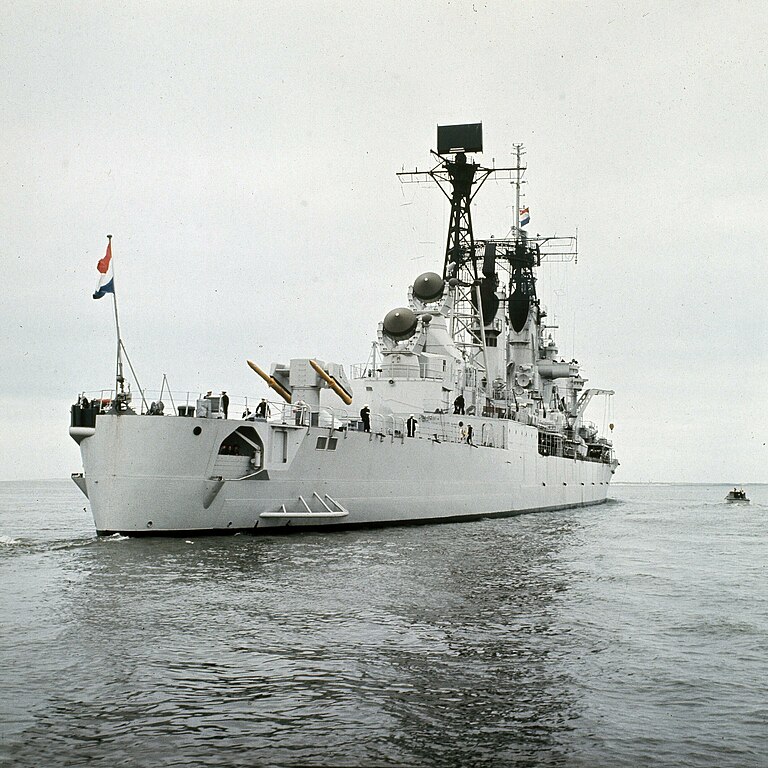
In 1954, plans were made to convert both cruisers to missiles. A first attempt at cooperation with Great Britai to combined British missiles and Dutch radars came to naught and so by 1958, the Netherlands entered negotiations with the United States to provide the RIM-2 Terrier SAM. The US offered the Netherlands two such weapon systems (for the equivament of 120 million guilders) and the Netherlands paid the installation costs in addition, circa 40 million guilders. The House of Representatives however blocked the funds, so it was decided to equip only De Zeven Provinciën.
The rear two twin turrets and aft twin AA mounts and assoviated structures were removed and the whole underdeck section reworked to free space for the new system. The aft mast was moved away from the funnel, closer to the missile installation. Rotating magazines and a conveyor belt with 40 missiles were built undernearth the twin deck launcher. On April 10, 1962, conversion commenced, and lasted until 1964. De Zeven Provinciën not only became the first and last Dutch missile cruiser, but also the very first missile ship in the Navy.
In addition to the new Terrier SAM, De Zeven Provinciën received the corresponding radar, on US patterns, the AN/SPS-39 3D air warning radar and two AN/SPG-55 Fire Control radars for the two launchers. The AN/SPS-39 procured to the operators a far better aerial image with direct height determination, negating the use of the former VI-01 radar.
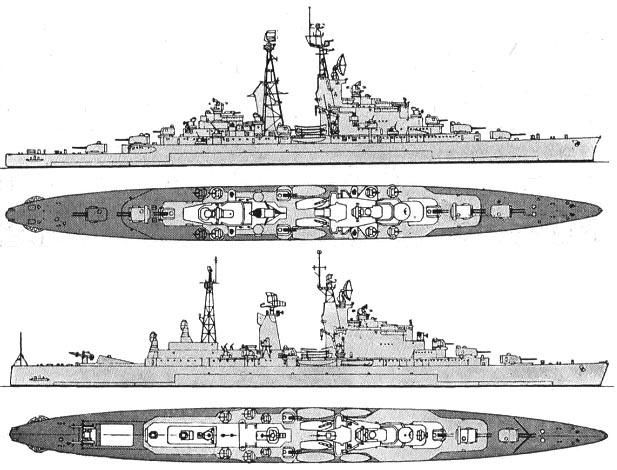
Evolution of De Ruyter class in 1965, with the former at the top in 1965, and the De Zeven Provincien in 1964 after SAM refit. – Conway’s via navypedia
⚙ De Ruyter class specifications 1955 |
|
| Dimensions | 185.7/187.3 oa x 17.3 x 5.60-6.70 (614.6 x 56.6 x 22 ft) |
| Displacement | 9,529t standard, 11,850t FL |
| Propulsion | 3 Schelde/Parsons geared steam turbines, 4 Werkspoor-Yarrow/6 Yarrow boilers 85,000 shp |
| Speed | Same, 32 knots |
| Protection | belt 50-75mm, deck 20-30mm, same, see notes |
| Range | Oil 1,750t, 7,000nm at 12 kts |
| Armament | Bofors 4×2 152mm/53 DP M42, 4×2 57mm/60 M50, 8x40mm, see notes |
| Sensors | LW-01, DA-01, VI-01, M25 and M45 (guidance), see notes. |
| Crew | 923, 973 as flagship |
 HNLMS De Ruyter (1944)
HNLMS De Ruyter (1944)
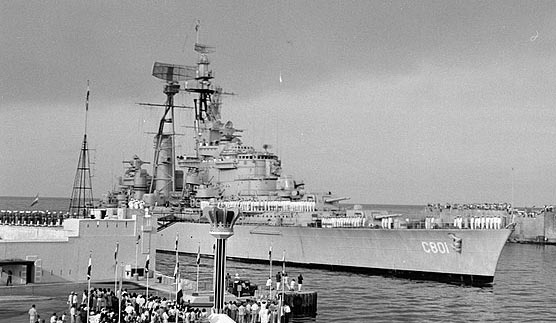
De Ruyter was not commissioned until November 18, 1953. After workout and fixes, then her shakedown cruiser, weapons drills in home waters, she was declared ready for service on late 1954. By June 13, 1955, she was moored and showcased to the public at the IJ Vlootweek in Amsterdam. On September 19, she departed from Den Helder to the Netherlands Antilles, her first transatlatic trip. Queen Juliana and Prince Bernhard came aboard for a cruise, visiting various islands. On 9 November she was back to home port Den Helder. On October 16, 1956, Queen Juliana visited her together with the President of Liberia during his state visit to the Netherlands.
On 14 May 1959, De Ruyter and the destroyers Limburg and Drenthe departed from Den Helder for Aarhus, Denmark and embarked the Persian shah for a state visit to the Netherlands. They arrived in Amsterdam on May 20. On March 1, 1960, she departed Den Helderwith the destroyers Drenthe, Limburg, Overijssel, Gelderland, the frigate De Bitter and submarine Zwaardvis for a cruiser to Morocco and Spain. On March 2-3 her crews provided assistance after an earthquake in Agadir. They were back to Den Helder on 2 April.
On January 30, 1964, De Ruyter departed as flagship with the destroyers Rotterdam and Holland from Den Helder for a long training cruise in the Mediterranean Sea. The sub. Zeeleeuw and frigate De Zeeuw joined them later. On February 21, they entered Valletta, Malta. On November 21, De Ruyter collided with the Spanish ship Mallor Quin near Barcelona. The latter sank, with one drawned but the rest were rescued by De Ruyter, which had no damage.
On 16 May 1969, she was part of the fleet review for NATO’s 20th anniversary, in a fleet of 12 different countries, 63 warships, held at Spithead.
This was her last great event. Afterwards, De Ruyter went on with her routine service, but under budget constraints, meaning no long cruise, more time spent in port and more crew leaves. In late 1971 it was understood she would be decommissioned, and preparations were made in early 1972.
 BAP Almirante Grau
BAP Almirante Grau
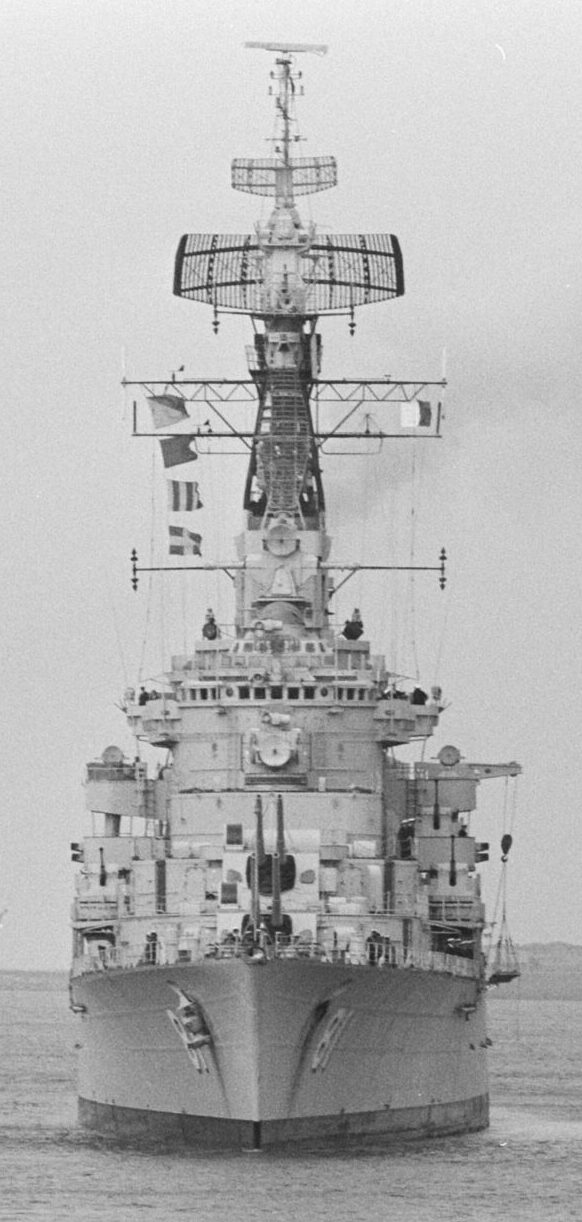
BAP Almirante Grau leaves the port of Curaçao.
On October 13, 1972, after decommission, “The seven Provinces” was sold to Peru for c22 million guilders (c12,200,000 dollars 1975). She was recommissioned on May 23, 1973 as BAP Almirante Grau and immediately became the flagship of the Peruvian Navy until September 26, 2017, as the last conventional active service cruiser in the world. Modernization: Almirante Grau was modernized in Amsterdam from 1985 to 1988 and at this occasion “Aguirre” was renamed Almirante Grau and and retook the role of flagship. After the return of the Almirante Grau, on February 15, 1988, both ships returned to their designated names.
The Peruvian Navy decommissioned Almirante Grau in 2017. She briefly served with a foundation but was returned to the Navy due to the Covid-19 pandemic. In 2021, the Peruvian Navy put her for sale for 981,000 euros and by July 8, she was towed from Lima to Ecuador’s largest steel company Adelca, to be broken up. With that, the very last, most modern conventional cruiser in history disappeared.
 HNLMS De Zeven Provincien (1950)
HNLMS De Zeven Provincien (1950)
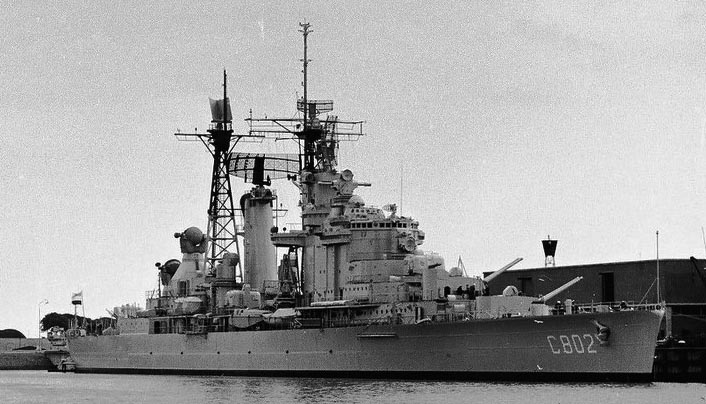
When launched on August 22, 1950, final name De Zeven Provinciën was given at the request of Wilton-Fijenoord and christened by Queen Juliana. She only started her operational life with a commission on December 17, 1953 a long delay towork out all her new system. She was indeed the most complicated and costly ship ever in the Netherlands.
On July 14, 1956 she departed with the destroyers HtMs Friesland and Zeelandfrom Den Helder for Leningrad and Stockholm. On July 20 they arrived at Leningrad (a first for a NATO ship !), accompanied all the way by four patrol vessels and a Russian destroyer.

From 15 to 24 March 1957, she participated in joint exercises with Canadian and US naval units, off Puerto Rico and visited the Dutch West Indies and Venezuela.
From 2 to 7 July, she took part in “flee days” in Vlissingen. Other ships present were the O 21, destroyer NoordBrabant, British frigate HMS Russell, at the occasion of Michiel de Ruyter’s 350th birthday. On October 28, 1958, she made an official visit to Copenhagen at the occasion of the commemoration of the battle in the Sont. On July 6, 1961, she took part in a naval review takes off the coast of Scheveningen (Four Days Battle commemoration) with 30 other ships in addition of her sister De Zeven Provinciën and the aircraft carrier Karel Doorman. The fleet saluted also Queen Juliana and Prince Bernhard present as guest hosts.
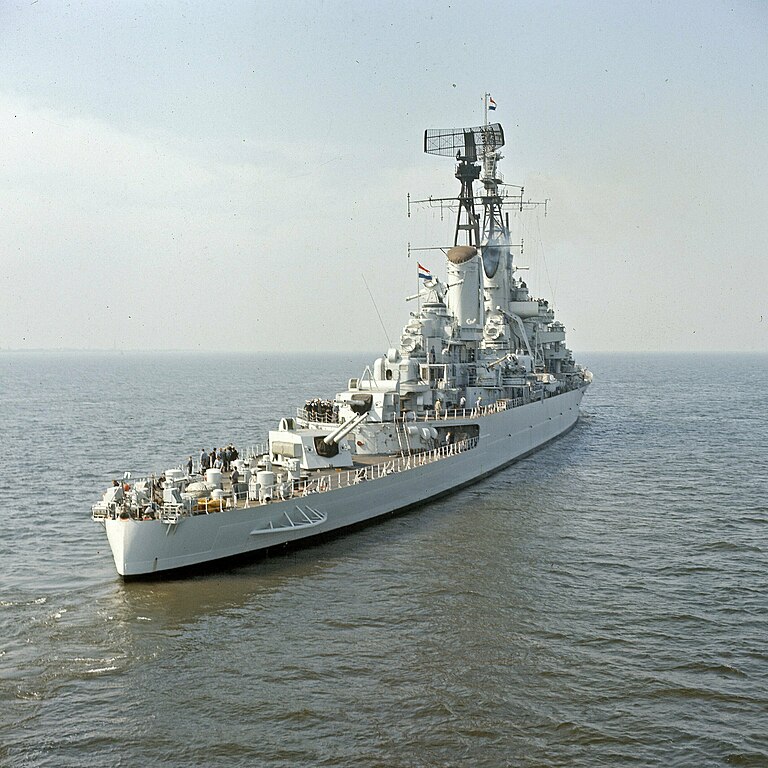
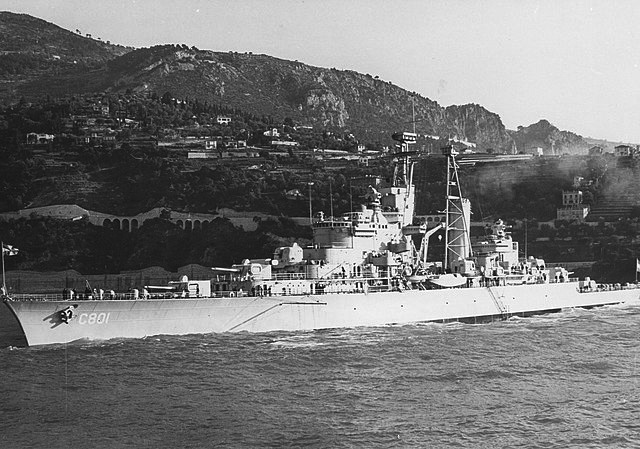
In 1962, De Zeven Provinciën was equipped with a Terrier guided weapon system unlike De Ruyter. On September 7, 1964, she made her maiden voyage to Dakar after her sea trials and back to Den Helder.
On March 30, 1965 De Zeven Provinciën started a cruiser to the Americas, arriving to Norfolk, and then touring Florida and Rio de Janeiro, then back in HP Den Helder, June 28, 1965. She also took part in the celebration of the 400th anniversary in Rio de Janeiro, winning the second prize as most beautiful ship in the harbor and roadstead at this event, beaten by a Portuguese three-masted TS.
On February 5, 1973 De Zeven Provinciën and the destroyers Amsterdam, Drenthe and Holland departed from Den Helder for another goodwill tour and show the flag mission to the Americas. Later the squadron was joined by the British frigate HMS Minerva, while escorting Prince Charles. By March 29, 1973 they were back to Den Helder.
In October 1975 she was decommissioned, then sold to Peru on August 17, 1976, following her sister De Ruyter, rebuilt as a helicopter cruiser. This was the very last cruiser from the Dutch navy. Her new life in Peru as BAP Almirante Aguirre would be long, as she was retired not before 1999, and her sister much later.
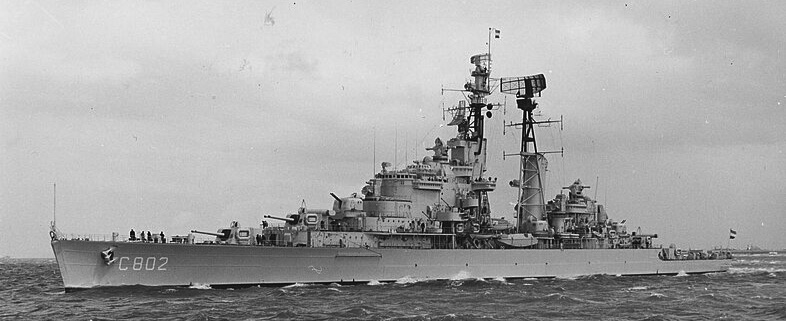
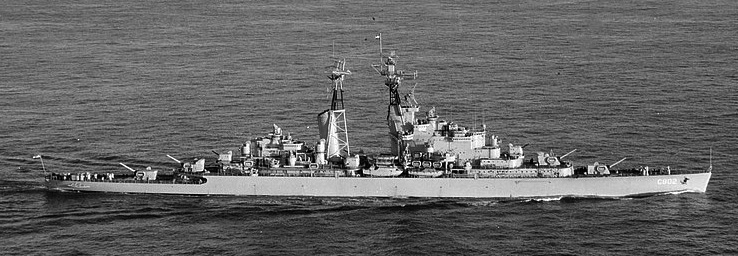
 BAP Aguirre
BAP Aguirre
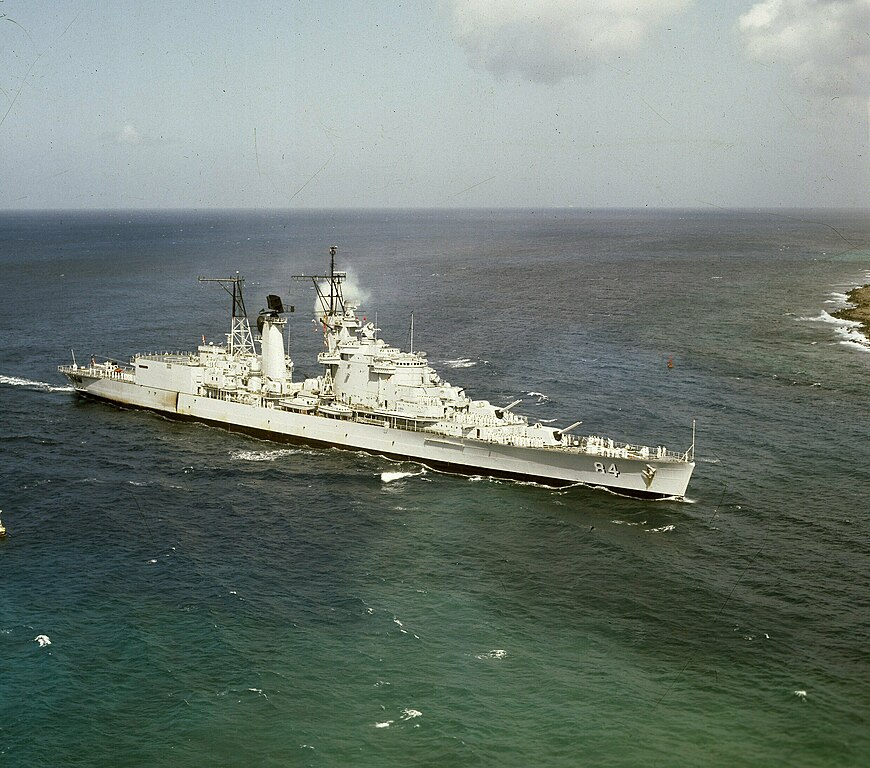
BAP Aguirre (CH-84) of the Peruvian Navy fas the former HtMs De Ruyter, decommissioned in 1976. She was sold to Peru after quite an extensive modernization at the Rotterdamse Droogdok Maatschappij (RDM), Rotterdam shipyards. The SAM RIM-2 Terrier missile launching systems were removed, a hangar was installed and new reinforced landing deck to accomodate the largest Peruvian helicopters. Upgrades being completed on 31 October 1977 she was officially recommissioned on 24 February 1978 at the naval base at Den Helder. Renamed Aguirre, the peruvian flag was hoisted with a band and full staffs of the Dutch and Peruvian navies. The name was ship in honor of Peruvian commander Elías Aguirre. The brand new cruiser sailed out with her newly arrived Peruvian crew, proceeding to the port of Callao on May 17, 1978.
In service as BAP Aguirre, she participated in several missions, multinational training execizes with UNITAS (other south american navies). From 7 August 1986 to 15 February 1988, while Almirante Grau (former De Zeven Provincien) was undergoing a major modernization in the Netherlands in turn, Aguirre was temporarily renamed “Almirante Grau” and performed as flagship of the Peruvian fleet.
At the end of the 90s, her electronics systems began to show their age, as well as the hull and machinery, in operation since 50 years. Due to the lack of financial resources a new modernization and overhaul were denied but funds were alocated to her sister. She did not made much more missions afterwards, was placed in reserve and eventually decommission on March 21, 1999. She was stricken, sold and scrapped in 2000. One of the very last active gun cruiser to be retired and not extant as a museum ship.
General assessment of the class
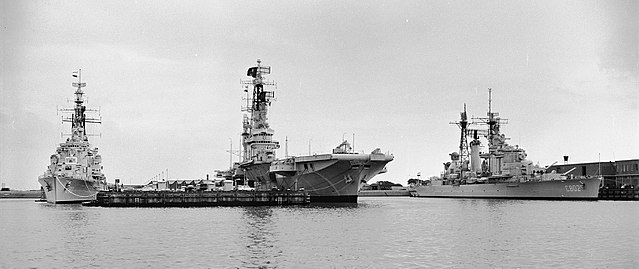
Backbone of NATO W Europe ASW forces: Karel Doorman and her escorts, the De Ruyter class cruisers.
De Ruyter and De Zeven Provinciën made a considerable boost to the postwar Netherlands Navy, which was decimated in the simultaneous german attempted takover of home naval assets, and the Japanese rampaging thorough the East Indies and sinking most of the KNIL in the process. There were free netherlands ships and sailors took an important part in allied naval operations.
However, the postwar context was difficult to say the least, and the completion of two domestic, large cruisers, and soon the acquisition in April 1948 of the aicraft carrier HtMs Karel Doorman completely rebuilt the Netherlands navy around this solid core.
They were redesigned as mixed conventional/AA cruisers, to be the sailors of tne new carrier and create the first modern task force of the Dutch Navy. All three, often berthed together, helped boosting morale in post-war years and helped to ensure the Netherlands’s place within NATO, specialized soon in ASW warfare. In the late 1950s and early 1960s they became the NL presite ship, flagships and ambassadors, showing the flag around the world. However in the 1960s they started to show their age and already budget restrictions only allowed a single cruiser to be upgraded as hybrid conventional/missile cruisers.
Then 1970s further budget cuts and NATO reorganization impacted the Dutch Navy, which was in short not longer tasked of ASW warfare as priorities changed, but to focus of mine warfare instead (Benelux countries in general) which favoured smaller ships and suited better the new budgetary trend. With their 900+ sailors, high fuel consumption, the two cruisers were likely not to survive NtMs Karel Doorman, which was decommissioned by 29 April 1968. The 1962-64 refit of De Zeven Provinciën as missile ship helped to keep her relevant for another decade while her sister ship started to be sidelined.
It should be noted that the Dutch squadron halted in July 1956 (De Zeven Provinciën, Friesland and Zeeland) to Leningrad for a courtesy call. This was very special occasion since the Netherlands was part of NATO opposite the Soviet Union. There was a tragedy also, when on November 21, 1964, De Ruyter collided with the Spanish ship Mallor Quin, and the latter sank, with one drowned and the rest rescued. De Zeven Provinciën went to Dakar for her unaugural cruise as missile ship. However both ships were feeling their age and by October 12, 1972 De Ruyter was decommissioned, and from February 5, 1973 De Zeven Provinciën made a “goodby tour” in the Americas. She was not long to follow her sister, by October 16, 1975 so her modernization also won four years of extra service.
The deal with the Peruvian Navy went as a pleasant surprise of cash for the Dutch government as in the mid-1970s large cruisers were not an affluent commodity that was looked for. Following the Argentines, Brazilians and Chileans which acquired WW2 veteran cruisers (Belgrano was later sunk in 1982 but that’s another story), the two cruisers found a new life in the Pacific. A long life, but after modernization as helicopter cruiser of Aguirre (her fifth reconstruction!), and modernization of Grau, the two served amazingly until 1999 and late 2017, an amzing fact given their hull has been laid down in 1939, 78 years at sea for the second ! …
So not only these ships were the last conventional cruisers ever built, but certainly also among the longest-lived cruisers of all times, proving the quality of construction and versatility of the Dutch design.

Read More
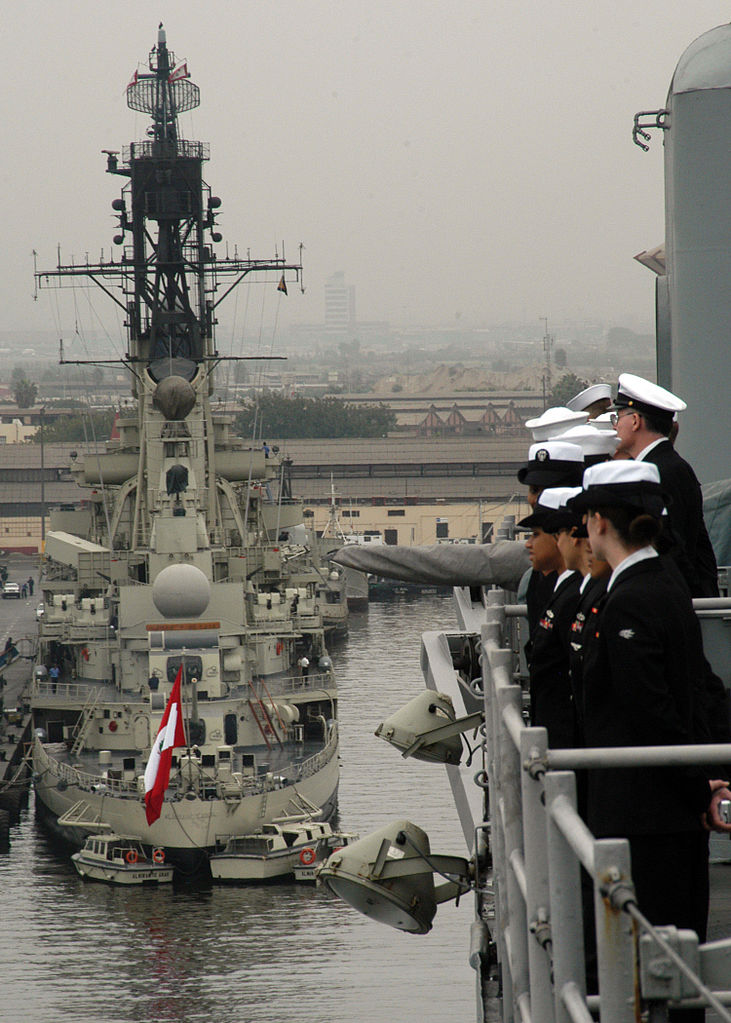
A farewell from the US Navy: U.S. Navy Sailors aboard USS Pearl Harbor (LSD 52) over look a Peruvian navy ship while pulling in to Callao, Peru, July 2, 2007, during Partnership of the Americas (POA) 2007. POA is focusing on enhancing relationships with partner nations through a var iety of exercises and events at sea and on shore throughout South America, Latin America, and the Caribbean, 2 July 2007.
Books
Conway’s all the world’s fighting ships 1947-95
Article by L.L. von Munching is from Warship International, N. 4, 1976.
Links
https://nl.wikipedia.org/wiki/De_Zeven_Provinci%C3%ABnklasse_(kruiser)
http://www.military-today.com/navy/de_zeven_provincien_cruiser.htm
https://www.netherlandsnavy.nl/Eendracht.htm
http://www.military-today.com/navy/de_zeven_provincien_cruiser.htm
http://www.navypedia.org/ships/netherlands/nl_cr_de_zeven_provincien.htm
https://commons.wikimedia.org/wiki/Category:C801_Hr.Ms._De_Ruyter_(ship,_1953)#mw-subcategories
https://nl.wikipedia.org/wiki/De_Zeven_Provinci%C3%ABnklasse_(kruiser)

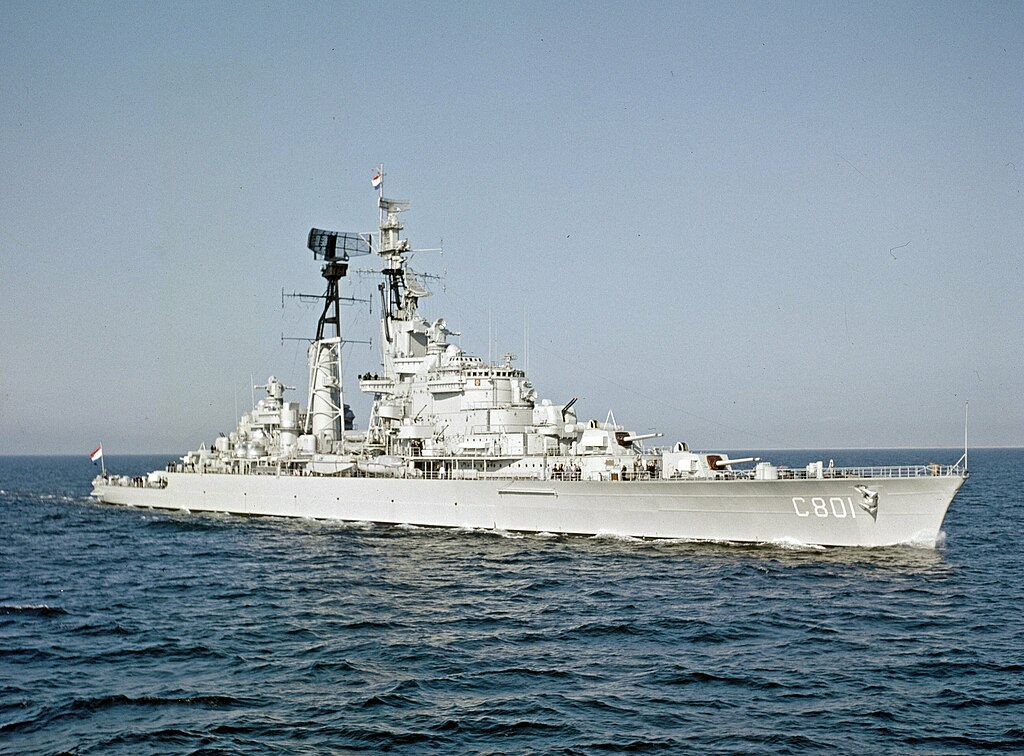
 Latest Facebook Entry -
Latest Facebook Entry -  X(Tweeter) Naval Encyclopedia's deck archive
X(Tweeter) Naval Encyclopedia's deck archive Instagram (@navalencyc)
Instagram (@navalencyc)





 French Navy
French Navy Royal Navy
Royal Navy Russian Navy
Russian Navy Armada Espanola
Armada Espanola Austrian Navy
Austrian Navy K.u.K. Kriegsmarine
K.u.K. Kriegsmarine Dansk Marine
Dansk Marine Nautiko Hellenon
Nautiko Hellenon Koninklije Marine 1870
Koninklije Marine 1870 Marinha do Brasil
Marinha do Brasil Osmanlı Donanması
Osmanlı Donanması Marina Do Peru
Marina Do Peru Marinha do Portugal
Marinha do Portugal Regia Marina 1870
Regia Marina 1870 Nihhon Kaigun 1870
Nihhon Kaigun 1870 Preußische Marine 1870
Preußische Marine 1870 Russkiy Flot 1870
Russkiy Flot 1870 Svenska marinen
Svenska marinen Søværnet
Søværnet Union Navy
Union Navy Confederate Navy
Confederate Navy Armada de Argentina
Armada de Argentina Imperial Chinese Navy
Imperial Chinese Navy Marinha do Portugal
Marinha do Portugal Mexico
Mexico Kaiserliche Marine
Kaiserliche Marine 1898 US Navy
1898 US Navy Sovietskiy Flot
Sovietskiy Flot Royal Canadian Navy
Royal Canadian Navy Royal Australian Navy
Royal Australian Navy RNZN Fleet
RNZN Fleet Chinese Navy 1937
Chinese Navy 1937 Kriegsmarine
Kriegsmarine Chilean Navy
Chilean Navy Danish Navy
Danish Navy Finnish Navy
Finnish Navy Hellenic Navy
Hellenic Navy Polish Navy
Polish Navy Romanian Navy
Romanian Navy Turkish Navy
Turkish Navy Royal Yugoslav Navy
Royal Yugoslav Navy Royal Thai Navy
Royal Thai Navy Minor Navies
Minor Navies Albania
Albania Austria
Austria Belgium
Belgium Columbia
Columbia Costa Rica
Costa Rica Cuba
Cuba Czechoslovakia
Czechoslovakia Dominican Republic
Dominican Republic Haiti
Haiti Hungary
Hungary Honduras
Honduras Estonia
Estonia Iceland
Iceland Eire
Eire Equador
Equador Iran
Iran Iraq
Iraq Latvia
Latvia Liberia
Liberia Lithuania
Lithuania Mandchukuo
Mandchukuo Morocco
Morocco Nicaragua
Nicaragua Persia
Persia San Salvador
San Salvador Sarawak
Sarawak Uruguay
Uruguay Venezuela
Venezuela Zanzibar
Zanzibar Warsaw Pact Navies
Warsaw Pact Navies Bulgaria
Bulgaria Hungary
Hungary

 Bundesmarine
Bundesmarine Dutch Navy
Dutch Navy Hellenic Navy
Hellenic Navy Marina Militare
Marina Militare Yugoslav Navy
Yugoslav Navy Chinese Navy
Chinese Navy Indian Navy
Indian Navy Indonesian Navy
Indonesian Navy JMSDF
JMSDF North Korean Navy
North Korean Navy Pakistani Navy
Pakistani Navy Philippines Navy
Philippines Navy ROKN
ROKN Rep. of Singapore Navy
Rep. of Singapore Navy Taiwanese Navy
Taiwanese Navy IDF Navy
IDF Navy Saudi Navy
Saudi Navy Royal New Zealand Navy
Royal New Zealand Navy Egyptian Navy
Egyptian Navy South African Navy
South African Navy






























 Ukrainian Navy
Ukrainian Navy dbodesign
dbodesign